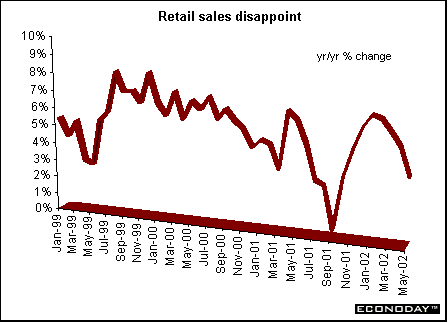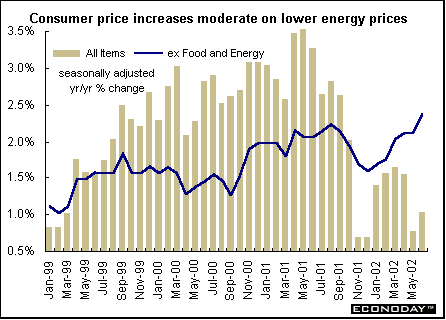
Indicator scoreboard
EMU - June M3 money supply growth slowed to 7.1 percent when compared with last year. The three-month moving average for the April-through-June period remained at 7.4 percent when compared with the same three months a year ago. The three-month moving average is a key indicator used by the European Central Bank, which currently maintains a 4.5 percent reference value for M3 money supply growth.

May seasonally adjusted merchandise trade surplus with the rest of the world was €9.2 billion, up from April's €7.4 billion surplus. Exports rose 1 percent while imports fell 1 percent.
Germany - June producer prices fell 0.1 percent and are down 1.1 percent when compared with last year. Energy prices, which account for 20 percent of the PPI, fell 0.6 percent and 5.9 percent on the year. Excluding energy prices, the PPI was up 0.1 percent and 0.2 percent on the year. Producer prices for semi-finished goods excluding energy, which accounts for about 31 percent of the producer price index, rose 0.2 percent but fell 0.7 percent on the year. Consumer goods, which account for about 27 percent of the PPI, slipped 0.1 percent but rose 0.4 percent on the year.
July Ifo Institute's west German business sentiment index sank to 89.9 from 91.3 in June. Both business expectations and current conditions dropped. Current conditions fell to 77.9 from 78.3 in June, while business expectations dropped to 102.5 from 104.9 in June. The decline in the business climate was particularly attributable to less favorable responses from manufacturing.

France - June seasonally and calendar-adjusted consumer spending on manufactured goods jumped 1.0 percent and 2.6 percent when compared with last year. Rising temperatures and summer discounts buoyed spending gains at the end of the month. Auto sales rebounded after a slump in May. By contrast, household durables fell after a previous boost to home entertainment purchases ahead of the World Cup.
Italy - May unadjusted retail sales rose 2.1 percent when compared with last year. Analysts do not closely watch the retail sales data because they show no correlation with consumer spending as published in quarterly GDP statistics. Indeed, ISTAT does not use its own retail sales data to compile its private consumption statistics.
June merchandise trade surplus with non-EU countries increased to €1.418 billion, compared with a surplus of €924 million last year. Exports fell 6.1 percent while imports plunged 11.7 percent. The trade balance with EU partners showed the May surplus dwindling to €3 million, compared with a surplus of €184 million a year ago. Exports sank 6.5 percent and imports dropped 5.2 percent.
Britain - June seasonally adjusted retail sales volumes fell 0.7 percent but were 4.6 percent above levels of a year earlier. The latest decline followed a revised 0.5 percent monthly drop in May and was the first consecutive monthly fall since October 1998. National Statistics advised caution, though, when interpreting monthly changes in sales in both May and June due to problems with the seasonal adjustment factor. The late May bank holiday was put back a week this year and fell in June while an extra public holiday for the Queen's Golden Jubilee was also added in June. Non-food sales, household goods and non-specialized store sales declined. But textile, clothing and footwear sales rose.

Second quarter preliminary gross domestic product climbed 0.9 percent and 1.5 percent when compared with last year. Services rose 0.6 percent and 2.1 percent on the year. No estimate of the industrial sector is made for the preliminary release, but the lion's share of growth looks to have come from a bounce back in this sector following six quarters of consecutive decline.

Belgium - July Belgian National Bank business composite sentiment indicator fell to minus 6.5 after falling to minus 5.5 in June. Before this, the indicator had been recovering gradually from a seven-year low in September 2001. Manufacturing sector sentiment dropped 1.9 points to minus 7.4 after a 3.9-point drop in June. Executives reported a slowdown in recent production and a further slight decline in domestic orders. The Belgian manufacturing sentiment is widely seen as a reliable indicator for eurozone growth six months ahead, given the sector's large semi-finished goods branch and its dependence on European demand.
Asia
Japan - May tertiary industry index, which tracks business at retailers, banks and other service providers, rose 1 percent but fell 1 percent when compared with last year. The index rose after falling a revised 1.6 percent in April. Demand at transport and communication providers fell 0.9 percent. Demand for financial services and insurance rose 2.4 percent and demand at wholesalers, retailers and restaurants increased 1.4 percent. The all-industry activity index, which adds factory production, government spending and other components to the tertiary index and is used to gauge gross domestic product, rose 1.1 percent from April.
June seasonally adjusted merchandise trade surplus rose to ¥1.3 trillion from ¥619 billion in May. When compared with last year, the trade surplus rose to ¥1.3 trillion yen from ¥759 billion yen. Exports rose 8.9 percent and imports fell 5.1 percent on the year. Japan's trade surplus with the United States increased 5.6 percent to ¥617.4 billion on the year.
June seasonally adjusted retail sales fell 0.4 percent and 3.7 percent when compared with last year. Retail sales rose 1.1 percent in May. Sales at supermarkets and department stores rose 0.7 percent but fell 0.5 percent on the year. The World Cup and typhoons kept shoppers away in June.
July seasonally adjusted Tokyo consumer prices excluding fresh food rose 0.1 percent after being unchanged the previous two months. However prices excluding fresh food fell 1 percent from a year ago. June nationwide core consumer price index fell 0.7 percent and 0.8 percent on the year. Core CPI, which excludes volatile prices of fresh foods, fell for the 33rd straight month.
June real spending by households headed by a wage earner rose 2.2 percent after dropping 2.5 percent in May. When compared with last year, spending rose 3.4 percent. In the three months to June, spending was unchanged from the first quarter. The propensity to spend ratio, which rises when people spend more and save less, reached an 18-month high 73.7 percent in June.
Americas
Canada - May retail sales fell 1.3 percent after rising 1 percent in April. Retail sales are up 3.8 percent when compared with last year. The largest decline, 5.3 percent, was in the clothing sector, followed by "other retail" stores, which were down 2.7 percent. Drugstore sales and furniture sales were the only sectors to report higher sales.

June consumer prices rose 0.3 percent mainly due to cigarette tax increases and a rise in traveler accommodations prices. Declines in electricity and gasoline prices led the downward pressure. The CPI rose 1.3 percent while the index excluding energy jumped 2.6 percent when compared with last year. Seasonally adjusted CPI increased by 0.2 percent on the month and 1 percent on the year.



Last Week's Highlights • Global
Stock Market Indexes • Recap of Global Markets
• Currencies • Indicator
Scoreboard

The Bottom Line •
Looking Ahead
|